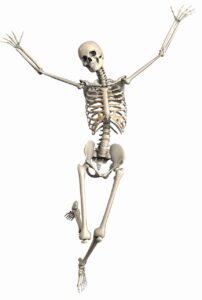
Between the ages of 25-30 our bone density is usually at its peak and by the age of 40 many people have started to have a decrease in their bone density. Here are some tips to help you maintain healthy bones despite the natural occurrence of decrease in density.
- Eating a nutritious diet is key! It is also important to make sure that you are not in a caloric deficit state as your body will begin to pull from your bones to make up for this deficit. Yes, calcium and vitamin D are important for your bones, but there are other nutrients to consider that are key as well. A few other important factors to include are magnesium, phosphorus, protein, and potassium. It is crucial that we mention that some studies have shown that for individuals who are highly active and not consuming enough carbohydrates, may also be at risk for injuries associated with decrease in bone density.
- Exercise plays a significant role in influencing bone density. Weight-bearing and resistance exercises are particularly beneficial for bone health. Here’s how different types of exercise can impact bone density.
- Weight-bearing exercises involve supporting your own body weight against gravity. They stimulate bone-forming cells (osteoblasts) to create new bone tissue and help maintain or increase bone density. Examples include walking, jogging, dancing, hiking, and stair climbing.
- Resistance or strength training exercises involve using external resistance (like weights, resistance bands, or your own body weight) to work against muscle contraction. This type of exercise helps build and strengthen muscles, which in turn exerts force on bones, promoting bone density. Examples include weightlifting, resistance band exercises, and bodyweight exercises like squats and push-ups. (We like weightlifting activities that target your axial skeleton or your spine to help with managing bone density throughout the spine and hips.)
- Impact sports Activities that involve sudden changes in direction or jumping, such as basketball, volleyball, and tennis, can help stimulate bone formation due to the higher forces placed on bones during these movements. Studies show that performing these
- Activities during adolescent years may be key for long-term bone health. But, let’s be honest if you are reading this you are probably a few years out from these years and we want you to know that the benefits of jumping or quick impact activities can still help your bones!
So, where do you go from here to help improve your bone health?
Hopefully these tips have you thinking about how important your diet and exercise are for your bones. We often hear how diet and exercise can impact our health in relation to our blood pressure and our heart, but we do not hear enough on the impact that these can have on the bones. Your skeleton system is the support of your body, and we want to make sure you are well informed to better support your body’s support system! So, start eating a nutritious diet, start exercising, and even throw in a few jumps to help your bone density.
We believe that everyone should be active and exercise for their overall health and well-being. However, certain modes of exercise may not be best for you and it is advised that you speak with your medical providers and/or seek appropriate guidance prior to engaging in exercised based activities.
References:
Allison SJ, Folland JP, Rennie WJ, Summers GD, Brooke-Wavell K. High impact exercise increased femoral neck bone mineral density in older men: a randomised unilateral intervention. Bone. 2013 Apr;53(2):321-8. doi: 10.1016/j.bone.2012.12.045. Epub 2013 Jan 3. PMID: 23291565.
Elhakeem A, Heron J, Tobias JH, Lawlor DA. Physical Activity Throughout Adolescence and Peak Hip Strength in Young Adults. JAMA Netw Open. 2020;3(8):e2013463. doi:10.1001/jamanetworkopen.2020.13463
Leigey D, Irrgang J, Francis K, Cohen P, Wright V. Participation in high-impact sports predicts bone mineral density in senior olympic athletes. Sports Health. 2009 Nov;1(6):508-13. doi: 10.1177/1941738109347979. PMID: 23015914; PMCID: PMC3445153.
Manaye S, Cheran K, Murthy C, Bornemann EA, Kamma HK, Alabbas M, Elashahab M, Abid N, Arcia Franchini AP. The Role of High-intensity and High-impact Exercises in Improving Bone Health in Postmenopausal Women: A Systematic Review. Cureus. 2023 Feb 5;15(2):e34644. doi: 10.7759/cureus.34644. PMID: 36895528; PMCID: PMC9990535.
